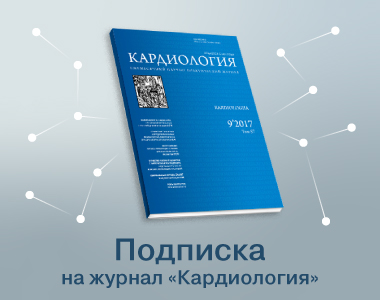Morphofunctional Predictors of Residual Ischemia After Myocardial Revascularization in Patients With Ischemic Cardiomyopathy and Reduced Left Ventricular Ejection Fraction
https://doi.org/10.18087/cardio.2025.9.n2985
Abstract
Aim To identify morpho-functional predictors for the development of residual myocardial ischemia after revascularization in patients with ischemic cardiomyopathy and left ventricular ejection fraction (LVEF) <35%.
Material and methods This prospective, non-randomized, single-center cohort study included 192 patients with a history of myocardial infarction, multivessel coronary disease, and LVEF <35%. Based on the evaluation of myocardial viability by delayed-enhancement magnetic resonance imaging (MRI) (criteria: transmurality index <0.5 and fibrosis volume <50% in arterial bed), 164 patients underwent myocardial revascularization, including percutaneous coronary intervention (PCI, n=92) or coronary artery bypass grafting (CABG, n=72). After 3-6 months, adenosine stress MRI was performed in all patients to assess the effectiveness of revascularization.
Results Functionally adequate revascularization was achieved in 93.9% of patients, without significant differences between the CABG and PCI groups (91.7 and 95.7%, respectively; p=0.305). Residual ischemia was detected exclusively in patients with incomplete anatomical revascularization. Multivariate analysis identified independent predictors of functionally inadequate revascularization: fibrosis volume >40% in the affected artery bed (odds ratio (OR) = 4.8; 95% confidence interval (CI) 2.1-10.9; p<0.001) and incomplete anatomical revascularization (OR = 6.2; 95% CI 2.7-14.1; p<0.001).
Conclusion The development of residual ischemia after revascularization in patients with low LVEF is determined by the severity of myocardial structural remodeling (fibrosis volume) and the anatomical completeness of revascularization, but is independent of the choice of revascularization method (PCI or CABG). A comprehensive preoperative evaluation, including visualization of the viable myocardium, is an important step in optimizing the management of these patients.
Keywords
About the Author
G. G. ImanovAzerbaijan
Assistant Professor of the Department of Internal Medicine 1
References
1. Murphy SP, Ibrahim NE, Januzzi JL. Heart Failure With Reduced Ejection Fraction: A Review. JAMA. 2020;324(5):488–504. DOI: 10.1001/jama.2020.10262
2. Vaduganathan M, Claggett BL, Jhund PS, Cunningham JW, Pedro Ferreira J, Zannad F et al. Estimating lifetime benefits of comprehensive disease-modifying pharmacological therapies in patients with heart failure with reduced ejection fraction: a comparative analysis of three randomised controlled trials. The Lancet. 2020;396(10244):121–8. DOI: 10.1016/S0140-6736(20)30748-0
3. Neumann F-J, Sousa-Uva M, Ahlsson A, Alfonso F, Banning AP, Benedetto U et al. 2018 ESC/EACTS Guidelines on myocardial revascularization. European Heart Journal. 2019;40(2):87–165. DOI: 10.1093/eurheartj/ehy394
4. McDonagh TA, Metra M, Adamo M, Gardner RS, Baumbach A, Böhm M et al. 2021 ESC Guidelines for the diagnosis and treatment of acute and chronic heart failure. European Heart Journal. 2021;42(36):3599–726. DOI: 10.1093/eurheartj/ehab368
5. Heidenreich PA, Bozkurt B, Aguilar D, Allen LA, Byun JJ, Colvin MM et al. 2022 ACC/AHA/HFSA Guideline for the Management of Heart Failure. Journal of Cardiac Failure. 2022;28(5):e1–167. DOI: 10.1016/j.cardfail.2022.02.010
6. Vrints C, Andreotti F, Koskinas KC, Rossello X, Adamo M, Ainslie J et al. 2024 ESC Guidelines for the management of chronic coronary syndromes. European Heart Journal. 2024;45(36):3415–537. DOI: 10.1093/eurheartj/ehae177
7. Shevchenko Yu.L., Borshchev G.G., Vahromeeva M.N., Vahrameeva A.Yu., Ulbashev D.S., Ermakov D.Yu. The importance of determining the viable myocardium in the patients with chd and diffuse lesion of coronary arteries. Bulletin of Pirogov National Medical & Surgical Center. 2024;19(2):89–93. DOI: 10.25881/20728255_2024_19_2_89
8. Babes EE, Tit DM, Bungau AF, Bustea C, Rus M, Bungau SG et al. Myocardial Viability Testing in the Management of Ischemic Heart Failure. Life. 2022;12(11):1760. DOI: 10.3390/life12111760
9. Shlyakhto E.V. Cardiology. National guidelines. Short edition. 2-nd ed. - M.: GEOTAR-Media; 2018. - 816p. ISBN 978-5-9704-4387-3
10. Velazquez EJ, Lee KL, Deja MA, Jain A, Sopko G, Marchenko A et al. Coronary-Artery Bypass Surgery in Patients with Left Ventricular Dysfunction. New England Journal of Medicine. 2011;364(17):1607–16. DOI: 10.1056/NEJMoa1100356
11. Perera D, Clayton T, O’Kane PD, Greenwood JP, Weerackody R, Ryan M et al. Percutaneous Revascularization for Ischemic Left Ventricular Dysfunction. New England Journal of Medicine. 2022;387(15):1351–60. DOI: 10.1056/NEJMoa2206606
12. Gerber BL, Rousseau MF, Ahn SA, Le Polain De Waroux J-B, Pouleur A-C, Phlips T et al. Prognostic Value of Myocardial Viability by Delayed-Enhanced Magnetic Resonance in Patients With Coronary Artery Disease and Low Ejection Fraction: impact of revascularization therapy. Journal of the American College of Cardiology. 2012;59(9):825–35. DOI: 10.1016/j.jacc.2011.09.073
13. Klem I, Weinsaft JW, Bahnson TD, Hegland D, Kim HW, Hayes B et al. Assessment of Myocardial Scarring Improves Risk Stratification in Patients Evaluated for Cardiac Defibrillator Implantation. Journal of the American College of Cardiology. 2012;60(5):408–20. DOI: 10.1016/j.jacc.2012.02.070
14. Shevchenko Yu.L., Borshchev G.G., Ulbashev D.S., Vakhrome eva M.N., Vakhrameeva A.Yu. Predicting the outcomes of cardiac revascularization depending on the contractility of the left ventricle and the amount of viable myocardium in patients with coronary artery disease. Russian Journal of Thoracic and Cardiovascular Surgery. 2020;62(6):563–70. DOI: 10.24022/0236-2791-2020-62-6-563-570
Review
For citations:
Imanov G.G. Morphofunctional Predictors of Residual Ischemia After Myocardial Revascularization in Patients With Ischemic Cardiomyopathy and Reduced Left Ventricular Ejection Fraction. Kardiologiia. 2025;65(9):56-60. (In Russ.) https://doi.org/10.18087/cardio.2025.9.n2985

















